Chapter 10
AN INTRODUCTION TO ASSET-BACKED SECURITIES24
There is a large group of bond instruments that trade under the overall heading of asset-backed bonds. These are created by bundling together a set of non-marketable assets - such as bank loans, mortgages, credit-card loans or other assets - and issuing bonds that are backed by this pool of assets. This process is known as securitisation, when an institution’s loan (assets) are removed from its balance sheet and packaged together as one large loan, and then ‘sold’ on to an investor, or series of investors, who then receive the interest payments due on the assets until they are redeemed. The purchasers of the securitised assets often have no recourse to the original borrowers; in fact, the original borrowers are not usually involved in the transaction or any of its processes.
Securitisation was introduced in the US market, and this market remains the largest for asset-backed bonds. The earliest examples of such bonds were in the US mortgage market, where residential mortgage loans made by a thrift (building society) were packaged together and sold on to investors who received the interest and principal payments made by the borrowers of the original loans. The process benefited the original lender in a number of ways. One key benefit was that removing assets from the balance sheet reduced risk exposure for the bank and enhanced its liquidity position.
The effect of these benefits is increased with the maturity of the original loans. For example, in the case of mortgage loans, the term to maturity can be up to 25 years, perhaps longer. The bulk of these loans are financed out of deposits that can be withdrawn on demand, or at relatively short notice. In addition, it is often the case that, as a result of securitisation, the packaged loans are funded at a lower rate than that charged by the original lending institution. This implies that the bundled loans can be sold off at a higher value than the level at which the lending institution valued them. Put another way, securitising loans adds value to the loan book and it is the original lender that receives this value. Another benefit is that, as a result of securitisation, the total funding available to the lending institution may well increase due to its access to capital markets; in other words, the firm becomes less dependent on its traditional deposit base. And, finally, by reducing the level of debt on the lending institution’s balance sheet, it will improve the firm’s gearing ratio.
The main advantage to the investor of securitisation is that it offers a marketable asset-backed instrument to invest in. Often the instrument offers two levels of protection, the original assets and credit enhancement. The original assets will provide good security if they are well-diversified and equivalent in terms of quality, terms and conditions (e.g., the repayment structure and maturity of assets). A diversified asset base reduces the risk of a single drastic failure, while homogeneous assets make it more straightforward to analyse the loan base. If there is little or no liquidity in the original loans (no secondary market) then investors will often require credit enhancement in the form of an insurance contract, letters of credit, subordination of a second tranche which absorbs losses first, over-collateralisation (having more underlying assets than is represented by the amount of bonds issued) or a reserve fund, for the instrument to be sold at a price acceptable to the original lender. Ironically, by implementing one or more of the protection features described, securitisation provides a better credit risk for the investor than the loans represented to the original lender.
Securitisation began in the US housing market in 1970 after the Government National Mortgage Association (GNMA or ‘Ginnie Mae’) began issuing mortgage pass-through certificates. A pass-through is a security representing ownership in a pool of mortgages. The mortgages themselves are sold through a grantor trust and the certificates are sold in the capital markets. As with standard mortgages the interest and amortised principal are paid monthly. Later on, mortgage-backed bonds were issued with semiannual payments and maturities of up to 15 years, which were terms familiar to domestic bondholders. In 1983 collateralised mortgage obligations were issued, the collateral provided by mortgages issued by the Federal Home Loans Mortgage Corporation. Being government agencies, the bonds that they issue are guaranteed and, as such, carry little additional risk compared with US Treasury securities. They can therefore be priced on the same basis as Treasuries. However, they present an additional type of risk, that of pre-payment risk. This is the risk that mortgages will be paid off early, ahead of their term, a risk that increases when mortgages have been taken out at high fixed-interest rates and rates have subsequently fallen. The existence of this risk therefore dictates that these bonds pay a higher return than corresponding Treasury bonds. The term average life is used to describe the years to maturity for asset-backed bonds that have an element of pre-payment risk about them, and is obviously an estimate used by bond analysts.
Securitisation was introduced in the UK market in 1985. A number of institutions were established for the purpose of securitising mortgages and other assets such as car loans and credit-card debt. These included the National Home Loans Corporation, Mortgage Funding Corporation and First Mortgage Securities.
In this chapter we introduce the basic concepts of securitisation and look at the motivation behind their use, as well as their economic impact. We illustrate the process with a brief hypothetical case study.
THE CONCEPT OF SECURITISATION
Securitisation is a well-established practice in the global debt capital markets. It refers to the sale of assets, which generate cash flows, from the institution that owns them, to another company that has been specifically set up for the purpose, and the issuing of notes by this second company. These notes are backed by the cash flows from the original assets. The technique was introduced initially as a means of funding for US mortgage banks. Subsequently, the technique was applied to other assets such as credit-card payments and leasing receivables. It has also been employed as part of asset/liability management, as a means of managing balance sheet risk.
Securitisation allows institutions such as banks and corporates to convert assets that are not readily marketable - such as residential mortgages or car loans - into rated securities that are tradeable in the secondary market. The investors that buy these securities gain an exposure to these types of original assets that they would not otherwise have access to. The technique is well-established and was first introduced by mortgage banks in the US during the 1970s. The later synthetic securitisation market is much more recent, dating from 1997. The key difference between cash and synthetic securitisation is that in the former, as we have noted, the assets in question are actually sold to a separate legal company known as a special purpose vehicle (SPV).25 This does not occur in a synthetic transaction, as we shall see.
Sundaresan (1997, p. 359) defines securitisation as:
. . . a framework in which some illiquid assets of a corporation or a financial institution are transformed into a package of securities backed by these assets, through careful packaging, credit enhancements, liquidity enhancements and structuring.
The process of securitisation creates asset-backed bonds. These are debt instruments that have been created from a package of loan assets on which interest is payable, usually on a floating basis. The asset-backed market is a large, diverse market containing a wide range of instruments. Techniques employed by investment banks today enable an entity to create a bond structure from any type of cash flow; assets that have been securitised include loans such as residential mortgages, car loans and credit-card loans. The loans form assets on a bank or finance house balance sheet, which are packaged together and used as backing for an issue of bonds. The interest payments on the original loans form the cash flows used to service the new bond issue. Traditionally, mortgage-backed bonds are grouped in their own right as mortgage-backed securities (MBSs) while all other securitisation issues are known as asset-backed securities (ABS).
Reasons for undertaking securitisation
The driving force behind securitisation has been the need for banks to realise value from the assets on their balance sheet. Typically, these assets are residential mortgages, corporate loans and retail loans such as credit-card debt. Let us consider the factors that might lead a financial institution to securitise a part of its balance sheet. These might be for the following reasons:
• if revenues received from assets remain roughly unchanged but the size of assets has decreased, this will lead to an increase in the return on equity ratio;
• the level of capital required to support the balance sheet will be reduced, which again can lead to cost savings or allows the institution to allocate the capital to other, perhaps more profitable, business;
• to obtain cheaper funding - frequently, the interest payable on ABS is considerably below the level payable on the underlying loans. This creates a cash surplus for the originating entity.
In other words, the main reasons that a bank will securitise part of its balance sheet are:
• funding the assets it owns;
• balance sheet capital management;
• risk management and credit risk transfer.
We consider each of these in turn.
Funding
Banks can use securitisation to (i) support rapid asset growth, (ii) diversify their funding mix and reduce cost of funding, and (iii) reduce maturity mis-matches. The market for ABS is large, with an estimated size of US$1,000 billion invested in ABS issues worldwide annually, of which US$150 billion is in the European market alone.26 Access to this source of funding will enable a bank to grow its loan books at a faster pace than if they were reliant on traditional funding sources alone. Securitising assets also allows a bank to diversify its funding mix. Banks will not wish to be reliant on only a single or a few sources of funding, as this can be high-risk in times of market difficulty. Banks aim to optimise their funding between a mix of retail, interbank and wholesale sources. Securitisation has a key role to play in this mix. It also enables a bank to reduce its funding costs. This is because the securitisation process de-links the credit rating of the originating institution from the credit rating of the issued notes. Typically, most of the notes issued by SPVs will be higher rated than the bonds issued direct by the originating bank itself. While the liquidity of the secondary market in ABS is frequently lower than that of the corporate bond market, and this adds to the yield payable by an ABS, it is frequently the case that the cost to the originating institution of issuing debt is still lower in the ABS market because of the latter’s higher rating. Finally, there is the issue of maturity mis-matches. The business of bank asset-liability management (ALM) is inherently one of maturity mis-match, since a bank often funds long-term assets - such as residential mortgages - with short-term liabilities - such as bank account deposits or interbank funding. This can be removed via securitisation, as the originating bank receives funding from the sale of the assets, and the economic maturity of the issued notes frequently matches that of the assets.
Balance sheet capital management
Banks use securitisation to improve balance sheet capital management. This provides (i) regulatory capital relief, (ii) economic capital relief and (iii) diversified sources of capital. As stipulated in the Bank for International Settlements (BIS) capital rules,27 also known as the Basel rules, banks must maintain a minimum capital level for their assets, in relation to the risk of these assets. Under Basel I, for every $100 of risk-weighted assets a bank must hold at least $8 of capital; however, the designation of each asset’s risk-weighting is restrictive. For example, with the exception of mortgages, customer loans are 100% risk-weighted regardless of the underlying rating of the borrower or the quality of the security held. The anomalies that this raises, which need not concern us here, are being addressed by the Basel II rules which become effective from 2007. However, the Basel I rules, which have been in place since 1988 (and effective from 1992), are another driver of securitisation. As an SPV is not a bank, it is not subject to Basel rules and need only such capital that is economically required by the nature of the assets they contain. This is not a set amount, but is significantly below the 8% level required by banks in all cases. Although an originating bank does not obtain 100% regulatory capital relief when it sells assets off its balance sheet to an SPV, because it will have retained a ‘first-loss’ piece out of the issued notes, its regulatory capital charge will be significantly reduced after the securitisation.28
To the extent that securitisation provides regulatory capital relief, it can be thought of as an alternative to capital raising, compared with the traditional sources of Tier 1 (equity), preferred shares, and perpetual loan notes with step-up coupon features. By reducing the amount of capital that has to be used to support the asset pool, a bank can also improve its return-on-equity (ROE) value. This will be received favourably by shareholders.
Risk management
Once assets have been securitised, the credit risk exposure on these assets for the originating bank is reduced considerably and, if the bank does not retain a first-loss capital piece (the most junior of the issued notes), it is removed entirely. This is because assets have been sold to the SPV. Securitisation can also be used to remove non-performing assets from banks’ balance sheets. This has the dual advantage of removing credit risk and a potentially negative sentiment from the balance sheet, as well as freeing up regulatory capital as before. Further, there is a potential upside from securitising such assets: if any of them start performing again, or there is a recovery value obtained from defaulted assets, the originator will receive any surplus profit made by the SPV.
Benefits of securitisation to investors
Investor interest in the ABS market has been considerable from the market’s inception. This is because investors perceive ABS as possessing a number of benefits. Investors can:
• diversify sectors of interest;
• access different (and sometimes superior) risk-reward profiles;
• access sectors that are otherwise not open to them.
A key benefit of securitisation notes is the ability to tailor risk- return profiles. For example, if there is a lack of assets of any specific credit rating, these can be created via securitisation. Securitised notes frequently offer better risk-reward performance than corporate bonds of the same rating and maturity. While this might seem peculiar (why should one AA-rated bond perform better in terms of credit performance than another just because it is asset-backed?), this often occurs because the originator holds the first-loss piece in the structure.
A holding in an ABS also diversifies the risk exposure. For example, rather than invest $100 million in an AA-rated corporate bond and be exposed to ‘event risk’ associated with the issuer, investors can gain exposure to, for instance, 100 pooled assets. These pooled assets will clearly have lower concentration risk.
THE PROCESS OF SECURITISATION
We look now at the process of securitisation, the nature of the SPV structure and issues such as credit enhancements and the cash flow waterfall.
Securitisation process
The securitisation process involves a number of participants. In the first instance there is the originator, the firm whose assets are being securitised. The most common process involves an issuer acquiring the assets from the originator. The issuer is usually a company that has been specially set up for the purpose of the securitisation, which is the SPV. The SPV is a legal entity but is essentially a brass plate; it is usually domiciled offshore. The creation of an SPV ensures that the underlying asset pool is held separate from the other assets of the originator. This is done so that in the event that the originator is declared bankrupt or insolvent the assets that have been transferred to the SPV will not be affected. This is known as being bankruptcy-remote. Conversely, if the underlying assets begin to deteriorate in quality and are subject to a ratings downgrade, investors have no recourse to the originator.
By holding the assets within an SPV framework, defined in formal legal terms, the financial status and credit rating of the originator becomes almost irrelevant to the bondholders. The process of securitisation often involves credit enhancements, in which a third-party guarantee of credit quality is obtained, so that notes issued under the securitisation are often rated at investment-grade and up to AAA-grade.
The process of structuring a securitisation deal ensures that the liability side of the SPV - the issued notes - carries lower cost than the asset side of the SPV. This enables the originator to secure lower cost funding that it would not otherwise be able to obtain in the unsecured market. This is a tremendous benefit for institutions with lower credit ratings. Figure 10.1 illustrates the process of securitisation in simple fashion.
Mechanics of securitisation
Securitisation involves a ‘true sale’ of the underlying assets from the balance sheet of the originator. This is why a separate legal entity, the SPV, is created to act as the issuer of the notes. The assets being securitised are sold onto the balance sheet of the SPV. The process involves:
• undertaking ‘due diligence’ on the quality and future prospects of the assets;
• setting up the SPV and then effecting the transfer of assets to it;
• underwriting of loans for credit quality and servicing;
• determining the structure of the notes, including how many tranches are to be issued, in accordance with originator and investor requirements;
• the notes being rated by one or more credit rating agencies;
• placing of notes in the capital markets.
Figure 10.1 The securitisation process.

The sale of assets to the SPV needs to be undertaken so that it is recognised as a true legal transfer. The originator will need to hire legal counsel to advise it in such matters. The credit rating process will consider the character and quality of the assets, and also whether any enhancements have been made to the assets that will raise their credit quality. This can include over-collateralisation, which is when the principal value of notes issued is lower than the principal value of assets, and a liquidity facility provided by a bank.
A key consideration for the originator is the choice of the underwriting bank, which structures the deal and places the notes. The originator will award the mandate for its deal to an investment bank on the basis of fee levels, marketing ability and track record with assets being securitised.
SPV structures
There are essentially two main securitisation structures, amortising (pass-through) and revolving. A third type, the master trust, is used by frequent issuers.
Amortising structures
Amortising structures pay principal and interest to investors on a coupon-by-coupon basis throughout the life of the security, as illustrated in Figure 10.2. They are priced and traded based on expected maturity and weighted-average life (WAL), which is the time-weighted period during which principal is outstanding. A WAL approach incorporates various pre-payment assumptions, and any change in this pre-payment speed will increase or decrease the rate at which principal is repaid to investors. Pass-through structures are commonly used in residential and commercial MBS deals, and consumer loan ABS.
Figure 10.2 Amortising structure.
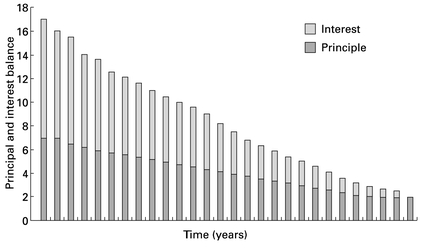
Revolving structures
Revolving structures revolve the principal of the assets; that is, during the revolving period, principal collections are used to purchase new receivables which fulfil the necessary criteria. The structure is used for short-dated assets with a relatively high pre-payment speed, such as credit-card debt and auto loans. During the amortisation period, principal payments are paid to investors either in a series of equal instalments (controlled amortisation) or principal is ‘trapped’ in a separate account until the expected maturity date and then paid in a single lump sum to investors (soft bullet).
Master trust
Frequent issuers under US and UK law use master trust structures, which allow multiple securitisations to be issued from the same SPV. Under such schemes, the originator transfers assets to the master trust SPV. Notes are then issued out of the asset pool based on investor demand. Master trusts have been used by MBS and credit-card ABS originators.
Securitisation note tranching
As illustrated in Figure 10.1, in a securitisation the issued notes are structured to reflect the specified risk areas of the asset pool, and thus are rated differently. The senior tranche is usually rated AAA. The lower rated notes usually have an element of over-collateralisation and are thus capable of absorbing losses. The most junior note is the lowest rated or non-rated. It is often referred to as the first-loss piece, because it is impacted by losses in the underlying asset pool first. The first-loss piece is sometimes called the equity piece or equity note (even though it is a bond) and is usually held by the originator.
Credit enhancement
Credit enhancement refers to the group of measures that can be instituted as part of the securitisation process for ABS and MBS issues, so that the credit rating of the issued notes meets investor requirements. The lower the quality of the assets being securitised, the greater the need for credit enhancement. This is usually by one of the following methods:
• Over-collateralisation - where the nominal value of the assets in the pool are in excess of the nominal value of issued securities.
• Pool insurance - an insurance policy provided by a composite insurance company to cover the risk of principal loss in the collateral pool. The claims-paying rating of the insurance company is important in determining the overall rating of the issue.
• Senior/Junior note classes - credit enhancement is provided by subordinating a class of notes (‘class B’ notes) to the senior class notes (‘class A’ notes). The class B note’s right to its proportional share of cash flows is subordinated to the rights of the senior noteholders. Class B notes do not receive payments of principal until certain rating agency requirements have been met, specifically satisfactory performance of the collateral pool over a predetermined period, or in many cases until all of the senior note classes have been redeemed in full.
• Margin step-up - a number of ABS issues incorporate a step-up feature in the coupon structure, which typically coincides with a call date. Although the issuer is usually under no obligation to redeem the notes at this point, the step-up feature was introduced as an added incentive for investors, to convince them from the outset that the economic cost of paying a higher coupon would be unacceptable and that the issuer would seek to refinance by exercising its call option.
• Excess spread - this is the difference between the return on the underlying assets and the interest rate payable on the issued notes (liabilities). The monthly excess spread is used to cover expenses and any losses. If any surplus is left over, it is held in a reserve account to cover against future losses or (if not required for that), as a benefit to the originator. In the meantime the reserve account is a credit enhancement for investors.
• Substitution - this feature enables the issuer to utilise principal cash flows from redemptions to purchase new collateral from the originator. This has the effect of lengthening the effective life of the transaction as the principal would otherwise have been used to redeem the notes. The issuer is usually under no obligation to substitute and it is an option granted by the investor.
All securitisation structures incorporate a cash waterfall process, whereby all the cash that is generated by the asset pool is paid in order of payment priority. Only when senior obligations have been met can more junior obligations be paid. An independent third-party agent is usually employed to run ‘tests’ on the vehicle to confirm that there is sufficient cash available to pay all obligations. If a test is failed, then the vehicle will start to pay off the notes, starting from the senior notes. The waterfall process is illustrated in Figure 10.3.
Figure 10.3 Cash flow waterfall (priority of payments).
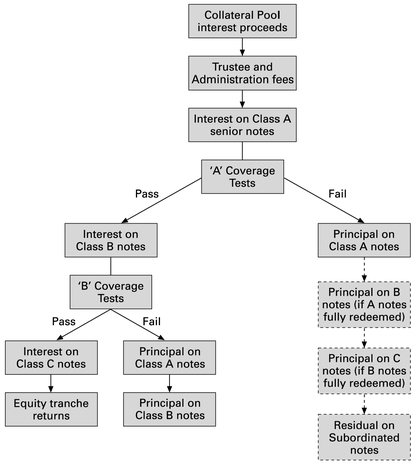
Impact on balance sheet
Figure 10.4 illustrates - by an hypothetical example - the effect on the liability side of an originating bank’s balance sheet from a securitisation transaction. Following the process, selected assets have been removed from the balance sheet, although the originating bank will usually have retained the first-loss piece. With regard to the regulatory capital impact, this first-loss amount is deducted from the bank’s total capital position. For example, assume a bank has $100 million of risk-weighted assets and a target Basel ratio of 12%,29 and securitises all $100 million of these assets. It retains the first-loss tranche which forms 1.5% of the total issue. The remaining 98.5% will be sold on to the market. The bank will still have to set aside 1.5% of capital as a buffer against future losses, but it has been able to free itself of the remaining 10.5 % of capital.
Figure 10.4 Regulatory capital impact of securitisation.

Credit rating
In the sterling market most public MBS and ABS are rated by one or more of the largest credit-rating agencies: Moody’s, Fitch and/or S&P. In structured financings it is normal for the rating of the paper to be investment-grade, with most issues at launch being rated Aaa and/or AAA. We can briefly touch on the issues involved in rating such paper. The rating of the issue is derived from a combination of factors. Insofar as it cannot generally be expected that investors will be sufficiently protected by the performance of the collateral alone, the rating agencies look to minimise the risk of principal default and ensure timely payment of interest coupons by requiring additional enhancement. The percentage of additional enhancement is determined by analysing the ‘riskiness’ of the collateral under a range of stress-tested environments which seek to quantify the effect of various interest-rate, foreclosure and loss scenarios, which are largely based on the expected performance of the collateral base in a recession. Much of the analysis is based on performance in the US markets, and the rating agencies try to establish criteria for each market and collateral type that is rated. The amount of enhancement required depends on the rating required at launch; for instance, less is required for a lower rated issue. In many cases issues will be backed by a larger nominal value of collateral; for example, an issue size of £100 million is formed out of assets composed of, say, £110 million.
Enhancement levels are also determined by the agencies reviewing the legal risks in the transaction. The legal analysis examines the competing rights and interests in the assets, including those of the bondholders and various third parties. MBS and ABS are typically issued out of low-capitalised SPV companies, established solely for the purpose of issuing the securities. The rating agencies need to be assured that there is no risk to the bondholders in the event of the originator - that is, the seller of the assets to the SPV - becoming insolvent, and to be certain that a receiver or administrator cannot seize the assets or obtain rights to the SPV’s cash flows. In the same way the agencies need to be satisfied that the SPV will be able to meet its obligations to its investors in circumstances where the service body (the entity responsible for administering the collateral, usually the originator) becomes insolvent. Consequently, significant emphasis is placed on ensuring that all primary and supporting documentation preserves the rights of investors in the security. An independent trustee is appointed to represent the interests of investors.
A change in rating for an ABS or MBS issue may be due to deterioration in performance of the collateral, heavy utilisation of credit enhancement or downgrade of a supporting rating - for example, an insurance company that was underwriting insurance on the pool of the assets.
Redemption mechanism
ABS and MBS issue terms incorporate one of two main methods through which redeeming principal can be passed back to investors:
• Drawing by lot - the available principal from the relevant interest period is repaid to investors by the international clearing agencies, Euroclear and Clearstream, drawing notes, at random, for cancellation. Notes will therefore trade at their nominal value.
• Pro rata - the available principal for the interest period is distributed among all investors, dependent upon their holding in the security. A pool factor is calculated, which is the remaining principal balance of the note expressed as a factor of 1. For instance, if the pool factor is 0.625 57, this means that for each note of £10,000 nominal, £3,744.30 of principal has been repaid to date. A pool factor value is useful to investors since early repayment of, say, mortgages reduces the level of asset backing available for an issue; the outstanding value of such an issue is reduced on a pro rata basis, like early redemption, by a set percentage so that the remaining amount outstanding is adequately securitised.
Average life
Some ABS structures will incorporate a call option feature. In some cases the terms of the issue prevent a call being exercised until a certain percentage of the issue remains outstanding, usually 10%, and a certain date has been passed.
It is common for ABS issues to have an average life quoted for them. This says that, based on the most recent principal balance for the security, it is assumed that a redemption rate is applied such that the resultant average life equals the number of months left from the last interest payment date until 50% of the principal balance remains. Some issuers will announce the expected average life of their paper, and yield calculations are based on this average life.
It is necessary to allow for the particular characteristics of ABS and MBS bonds. Reinvestment risk, the risk that the coupon payments are reinvested at a lower rate than the redemption yields, is more acute for ABS bonds because often payments are received as frequently as every month. The yield calculation, or cash flow yield, is dependent on realisation of the projected cash flow according to a set pre-payment rate. If actual pre-payments differ from that set by the pre-payment rate, the cash flow yield will not be realised.
At the time that an investor purchases an MBS, it is not possible to calculate an exact yield; this will depend on the actual pre-payments of mortgages in the pool. The convention in the market is to quote the yield as a spread over a comparable government bond. The repayment of principal over time makes it inaccurate to compare the yield of an MBS with a gilt or Treasury of a stated maturity. Market participants instead use two measures: Macaulay duration and average life. The average life is the average time to receipt of principal payments (projected scheduled principal payments and projected principal repayments), weighted by the amount of principal expected and divided by the total principal to be repaid. We can represent this using (10.1): where n is the number of months remaining.
where n is the number of months remaining.
(10.1)
ILLUSTRATING THE PROCESS OF SECURITISATION
To illustrate the process of securitisation, we consider an hypothetical airline ticket receivables transaction, being originated by the fictitious ABC Airways plc and arranged by the equally fictitious XYZ Securities Limited. We show the kind of issues that will be considered by the investment bank that is structuring the deal.
Case study.
| Originator | ABC Airways plc |
| Issuer | ‘Airways No 1 Ltd’ |
| Transaction | Ticket receivables airline future flow securitisation bonds |
| €200m three-tranche floating rate notes, legal maturity 2010 | |
| Average life 4.1 years | |
| Tranches | Class ‘A’ note (AA), Libor plus [ ] bps |
| Class ‘B’ note (A), Libor plus [ ] bps | |
| Class ‘E’ note (BBB), Libor plus [ ] bps | |
| Arranger | XYZ Securities plc |
Due diligence
XYZ Securities will undertake due diligence on the assets to be securitised. For this case, it will examine the airline performance figures over the last 5 years, as well as model future projected figures, including:
• total passenger sales;
• total ticket sales;
• total credit-card receivables;
• geographical split of ticket sales.
It is the future flow of receivables, in this case credit-card purchases of airline tickets, that is being securitised. This is a higher risk asset class than, say, residential mortgages, because the airline industry has a tradition of greater volatility of earnings than, say, mortgage banks.
Marketing approach
The present and all future credit-card ticket receivables enerated by the airline will be transferred to an SPV. The investment bank’s syndication desk will seek to place the notes with institutional investors across Europe. The notes are first given an indicative pricing ahead of the issue, to gauge investor sentiment. Given the nature of the asset class, during November 2002 the notes would be marketed at around 3-month Libor plus 70-80 basis points (AA note), 120-130 basis points (A note) and 260-270 basis points (BBB note). The notes are ‘benchmarked’ against recent issues with similar asset classes, as well as the spread level in the unsecured market of comparable issuer names.
Deal structure
The deal structure is shown at Figure 10.5.
Figure 10.5 Airways No 1 Ltd deal structure.
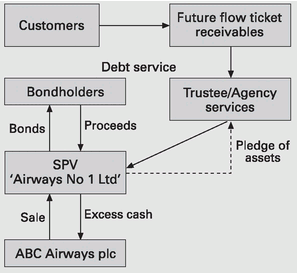
The process leading to issue of notes is as follows:
• ABC Airways plc sells its future flow ticket receivables to an offshore SPV set up for this deal, incorporated as Airways No 1 Ltd;
• the SPV issues notes in order to fund its purchase of the receivables;
• the SPV pledges its right to the receivables to a fiduciary agent, the Security Trustee, for the benefit of the bondholders;
• the Trustee accumulates funds as they are received by the SPV;
• the bondholders receive interest and principal payments, in the order of priority of the notes, on a quarterly basis.
In the event of default, the Trustee will act on behalf of the bondholders to safeguard their interests.
Financial guarantors
The investment bank will consider if an insurance company, known as a monoline insurer, should be approached to ‘wrap’ the deal by providing a guarantee of backing for the SPV in the event of default. This insurance is provided in return for a fee.
Financial modelling
XYZ Securities will construct a cash flow model to estimate the size of the issued notes. The model will consider historical sales values, any seasonal factors in sales, credit-card cash flows and so on. Certain assumptions will be made when constructing the model - for example, growth projections, inflation levels, tax levels and so on. The model will consider a number of different scenarios, and also calculate the minimum asset coverage levels required to service the issued debt. A key indicator in the model will be the debt service coverage ratio (DSCR). The more conservative the DSCR, the more comfort there will be for investors in the notes. For a residential mortgage deal, this ratio might be approximately 2.5-3.0; however, for an airline ticket receivables deal, the DSCR would be unlikely to be lower than 4.0. The model will therefore calculate the amount of notes that can be issued against the assets, whilst maintaining the minimum DSCR.
Credit rating
It is common for securitisation deals to be rated by one or more of the formal credit ratings agencies such as Moody’s, Fitch’s or S&P’s. A formal credit rating will make it easier for XYZ Securities to place the notes with investors. The methodology employed by the ratings agencies takes into account both qualitative and quantitative factors, and will differ according to the asset class being securitised. The main issues in a deal such as our hypothetical Airways No 1 deal would be expected to include:
• corporate credit quality - these are risks associated with the originator, and are factors that affect its ability to continue operations, meet its financial obligations and provide a stable foundation for generating future receivables. This might be analysed according to the following: (i) ABC Airways’ historical financial performance, including its liquidity and debt structure; (ii) its status within its domicile country (e.g., whether it is state-owned); (iii) the general economic conditions for industry and for airlines and (iv) the historical record and current state of the airline (e.g., its safety record and age of its aeroplanes);
• the competition and industry trends - ABC Airways’ market share, the competition on its network;
• regulatory issues - such as need for ABC Airways to comply with forthcoming legislation that would impact its cash flows;
• legal structure of the SPV and transfer of assets;
• cash flow analysis.
Based on the findings of the ratings agency, the arranger may re-design some aspect of the deal structure so that the issued notes are rated at the required level.
This is a selection of the key issues involved in the process of securitisation. Depending on investor sentiment, market conditions and legal issues, the process from inception to closure of the deal may take anything from 3 to 12 months or more. After the notes have been issued, the arranging bank will no longer have anything to do with the issue; however, the bonds themselves require a number of agency services for their remaining life until they mature or are paid off. These agency services include paying agent, cash manager and custodian.
Securitisation post credit crunch
Following the July-August 2007 implosion of the asset-backed commercial paper market, investor interest in ABS products dried up virtually completely. The growing illiquidity in the interbank market, which resulted in even large AA-rated banks finding it difficult to raise funds for tenors longer than 1 month, became acute following the collapse of Lehman Brothers in September 2008. To assist banks in raising funds, central banks starting with the US Federal Reserve and the European Central Bank (ECB), and then the Bank of England (BoE), began to relax the criteria under which they accepted collateral from banks which raised term funds from them. In summary, the central banks announced that asset-backed securities including mortgage-backed securities and other ABS would now be eligible as collateral at the daily liquidity window.
As originally conceived, the purpose of these moves was to enable banks to raise funds, from their respective central bank, using existing ABS on their balance sheet as collateral. Very quickly, however, the banks began to originate new securitisation transactions, using illiquid assets held on their balance sheet (such as residential mortgages or corporate loans) as collateral in the deal. The issued notes would be purchased by the bank itself, making the deal completely in-house. These new purchased ABS tranches would then be used as collateral at the central bank repo window.
Structuring considerations
Essentially an ECB-led deal is like any other deal except that it has a minimum requirement to be ECB-eligible. There are also haircut considerations and the opportunity to structure it without consideration for external investors. To be eligible for repo at the ECB, deals had to fulfil certain criteria. These included
a. ECB acceptability criteria:
- public rating of triple A or higher at first issue;
- only the senior tranche can be repo’d;
- no exposure to synthetic securities - the ECB rules stated that the cash flow in generating assets backing the asset-backed securities must not consist in whole or in part, actually or potentially, of credit-linked notes or similar claims resulting from the transfer of credit risk by means of credit derivatives; therefore, the transaction had to exclude any types of synthetic assets or securities;
- public presale or new-issue report issued by the agency rating the facility;
- listed in Europe (e.g., the Irish Stock Exchange);
- settlement book entry capability in Europe (i.e., Euroclear or Clearstream).
b. Haircut considerations:
- ABS securities denominated in euro incurred, from March 2009, a haircut of 12% regardless of maturity or coupon structure;
- for the purposes of valuation, in the absence of a trading price within the past five days, or if the price is unchanged over that period, a 5 % valuation markdown was applied - this equated to an additional haircut of 4.4%;
- ABS securities denominated in USD incurred the usual haircuts but with an additional initial margin of between 10% and 20% to account for FX risk.
c. Other considerations:
- the structure was allowed to incorporate a revolving period (external investors normally would not prefer this);
- structures were often issued as a simple two-tranche setup - the junior tranche could remain unrated and subordinated to topping up the cash reserve;
- at first, the ECB accepted securities with only one rating agency (the BoE required two); however, from March 2010 the ECB also required two rating agency ratings per security;
- no in-house currency swap hedge was allowed.
The originator also must decide whether the transaction is to be structured to accommodate replenishment of the portfolio or whether the portfolio should be static. ECB transactions are clearly financing transactions for the bank and as such the bank will wish to retain flexibility to sell or re-finance some or all of the portfolio at any time should more favourable financing terms become available to it. For this reason there is often no restriction on the ability to sell assets out of the portfolio provided that the price received by the issuer is not less than the price paid by it for the asset (par), subject to adjustment for accrued interest. This feature maintains maximum re-financing flexibility and has been agreed to by the rating agencies in previous transactions.
Example of in-house deal
During 2007-2009 over 100 banks in the European Union undertook in-house securitisations in order to access the ECB discount window, as funding sources in the interbank market dried up.30 A United Kingdom banking institution, the Nationwide Building Society, acquired an Irish banking entity during 2008 in order that it could access the ECB’s discount window (a requirement for which was to have an office in the Eurozone).
One such public deal was Fast Net Securities 3 Limited, originated by Irish Life and Permanent plc. Example 10.1 shows the deal highlights.
Example 10.1 Fast Net Securities 3 Limited (Source: S&P. Details reproduced with permission).
Note that the transaction displayed in Figure 10.6 was closed in December 2007, a time when the securitisation market was essentially moribund in the wake of the credit crunch. An ABS note rated AAA could be expected to be marked-to-market at over 200 bps over Libor. Because the issued notes were purchased in entirety by the originator, who intended to use the senior tranche as collateral to raise funds at the ECB, the terms of the deal could be set at a purely nominal level; this explains the ‘40 bps over Euribor’ coupon of the senior tranche.
BLOOMBERG SCREENS
We conclude this chapter with a selection of Bloomberg screens illustrating features of ABS and MBS.
The transaction under consideration is the GMAC Mortgage Corporation Loan Trust, a Master Trust vehicle. This deal, an MBS issue, had a large number of tranches, shown at Figure 10.6. The specific tranche we look at using other screens is the GMAC 2005-J1 A2 note.
Figure 10.7 shows the list of tranches for the deal. Figure 10.8 shows page DES for the A2 note. Note the pool factor of 1.000 000 00, this being the number we multiply the nominal amount by when calculating the market value of a holding of the bond. At this stage of the note’s life there had been no pay-down of principal, so the pool factor was still 1.00.
Figure 10.9 shows the yield table for the same bond, with the various assumed pre-payment rates ‘PSA’ shown that can be selected by the user. Figure 10.10 is the quick yield analysis page CFG.
Example 10.2 Fast Net Securities 3 Ltd
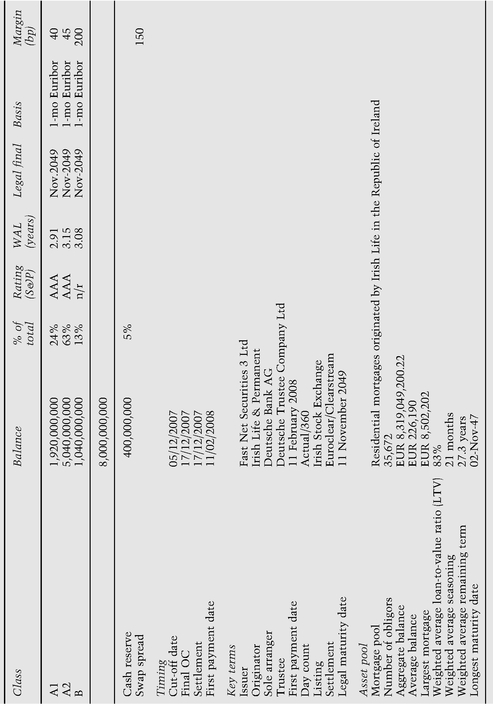

Figure 10.7 Bloomberg screen for GMAC MBS transaction.
© Bloomberg Finance L.P. All rights reserved. Used with permission.
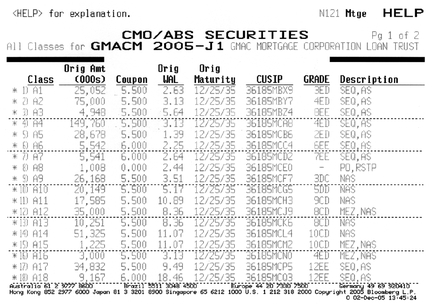
Figure 10.8 Bloomberg screen DES for GMAC 2005-J1 A2 note as at 2 December 2005, GMAC transaction.
© 2005 Bloomberg Finance L.P. All rights reserved. Used with permission.

Figure 10.9 Bloomberg screen YT for GMAC 2005-J1 A2.
© Bloomberg Finance L.P. All rights reserved. Used with permission.
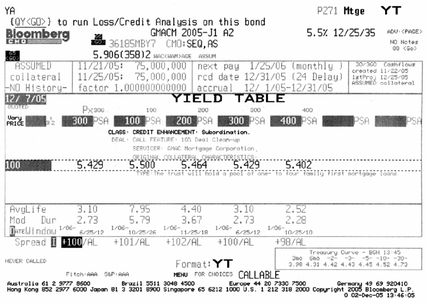
Figure 10.10 Bloomberg screen CFG for GMAC 2005-J1 A2.
© Bloomberg Finance L.P. All rights reserved. Used with permission.
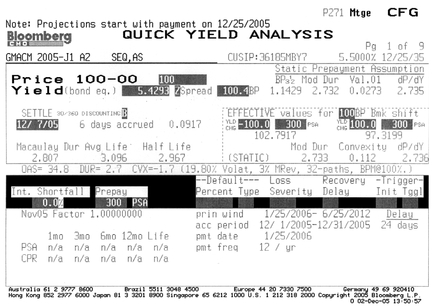
Figure 10.11 Bloomberg screen WALG for GMAC 2005-J1 A2 note.
© Bloomberg Finance L.P. All rights reserved. Used with permission.
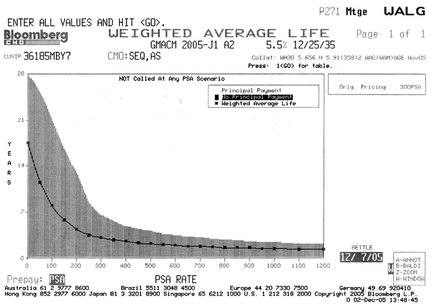
Figure 10.12 GMAC 2005-J1 A2 note projected cash flows.
© Bloomberg Finance L.P. All rights reserved. Used with permission.
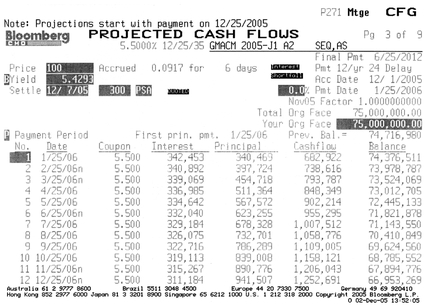
Figure 10.13 Bloomberg screen CFG for GMAC 2005-J1 A2 note.
© Bloomberg Finance L.P. All rights reserved. Used with permission.

Figure 10.11 shows the weighted average life for the A2 note, as at 2 December 2005, under the different assumed pre-payment scenarios. The different PSA rates are plotted along the x-axis. The weighted average life falls for a higher PSA number - as expected, because a higher PSA means a faster speed of pre-payment.
The projected cash flows for the A2 note are shown at Figure 10.12, and these can be viewed in graphical form using screen CFG, which is shown at Figure 10.13.
BIBLIOGRAPHY
Bhattacharya, A. and Fabozzi, F. (eds) (1996). Asset-Backed Securities, FJF Associates, New Hope, PA.
Choudhry, M. (2001). The Bond and Money Markets: Strategy, Trading, Analysis. Butterworth-Heinemann, Oxford, UK.
CSFB (2003), Credit Risk Transfer. CSFB, London.
Hayre, L. (ed.) (2001). The Salomon Smith Barney Guide to Mortgage-Backed and Asset-Backed Securities. John Wiley & Sons, New York, USA.
Martellini, L., Priaulet, P. and Priaulet, S. (2003). Fixed Income Securities, John Wiley & Sons, Chichester, UK.
Morris, D. (1990). Asset Securitisation: Principles and Practices, Executive Enterprise, London.
Sundaresan, S. (1997). Fixed Income Markets and Their Derivatives. SouthWestern Publishing, Southwestern University, IL, ch. 9.
..................Content has been hidden....................
You can't read the all page of ebook, please click here login for view all page.
